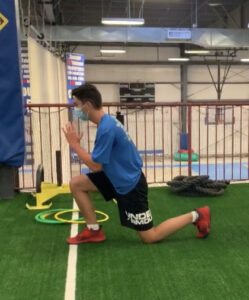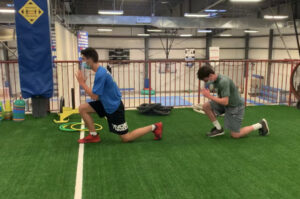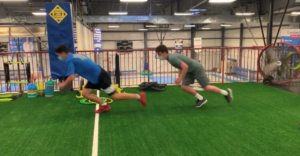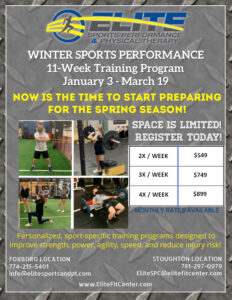Exercise of the Month – Half-Kneeling to Sprint
The half-kneeling to sprint is a staple drill used at Elite Sports Performance & Physical Therapy for helping our athletes improve speed and acceleration. Most of our athletes are familiar with the drill and have done multiple variations when working on different aspects of the acceleration phase. This is a excellent and effective drill to improve athletes’ ability to explode through their first step and increase their acceleration. These two components of sports performance are critical for any field sport athlete to master to achieve high performance levels.
To begin the exercise, the athlete starts down in a half kneeling position with one knee down on the ground. The knee on the ground starts under the hips. The foot of the back leg on the ground should be dorsiflexed and the toes should be up to allow to be used when pushing off at the start of the movement.
As for the front leg, the athlete positions the heel of the front foot slightly elevated off the ground, and weight shifted to the ball of the foot. The athlete’s knee is above the toes and hips of back and “loaded” (similar to the hip hinge position).
Overall, the starting position should look similar to the picture below.

On the coach’s command, the athlete accelerates forward by pushing through the front foot and elevating through the hips and shoulders at the same time in line with one another. Think about forming a diagonal line for how the athlete should progress through the movement. The hips and shoulders should move at the same time in the same direction. A common mistake for this drill is that an athlete will raise the hips first, usually by dropping the heel before trying to accelerate forward, resulting in a slower start. Once the athlete has elevated and initiated the acceleration phase, the athlete completes the exercise by sprinting 10 yards. The main focus of the drill are the first 3-4 steps as the previously mentioned goal is to improve the acceleration phase of sprinting.
A few coaching cues for this exercise include:
- Maintain a strong posture when on the ground.
- Keep front foot slightly elevated (no more than 1-1.5 inches off the ground).
- Keep shoulders in front of the toes during set up.
- Maintain shoulders in front of hips through acceleration phase.
- Every foot contact should be the ball of the foot (heel should not hit the ground).
Here at Elite Sports Performance & Physical Therapy, we perform a few different variations of this drill in training sessions depending on the athlete’s needs and goals. The most common variation is using 3 rings in which the athlete lands one foot at a time. The distances between rings are measured out for each athlete so they are working on the beginning of the acceleration phase over a longer period. The athlete’s shoulders should reach the ring before the hips or foot of the athlete reaches the ring.
Another variation commonly used at Elite is the half kneeling sprint with hurdles. The rings from the previous variation are replaced by 6” hurdles. The goal of this variation is for athletes to focus on driving their knee up while accelerating to avoid hitting a hurdle during the sprint.
The last commonly used variation at Elite is a half kneeling sprint partner chase. One athlete starts in front of another with about 2 yards between them. The athletes accelerate forward and sprint 10 yards while the second athlete tries to tag the first athlete before the first athlete reaches the finish line. A little friendly competition often make our athletes work that much harder while still focusing on their acceleration mechanics. During the first set of the series, the athletes are responding to the coach’s command for when to start their sprint. In the second set of the series, the first athlete decides when to start the sprint and the second athlete behind has to react to the first athletes’ movement.


We hope you enjoyed this installment of our Exercise of the Month! If you or an athlete in your family would like to join the Elite Sports Performance community, we offer Sports Performance and Athlete Training programs at both our Foxboro and Stoughton locations. To learn more about our programs for athletes of all ages and sports and how YOU can improve your acceleration, strength, power and performance in the process, click HERE or email us at EliteSPC@EliteFitCenter.com! See below for details about our upcoming Winter Training Special, which will run from January 3 – March 19 at both locations! Space is limited to secure your spot today!

